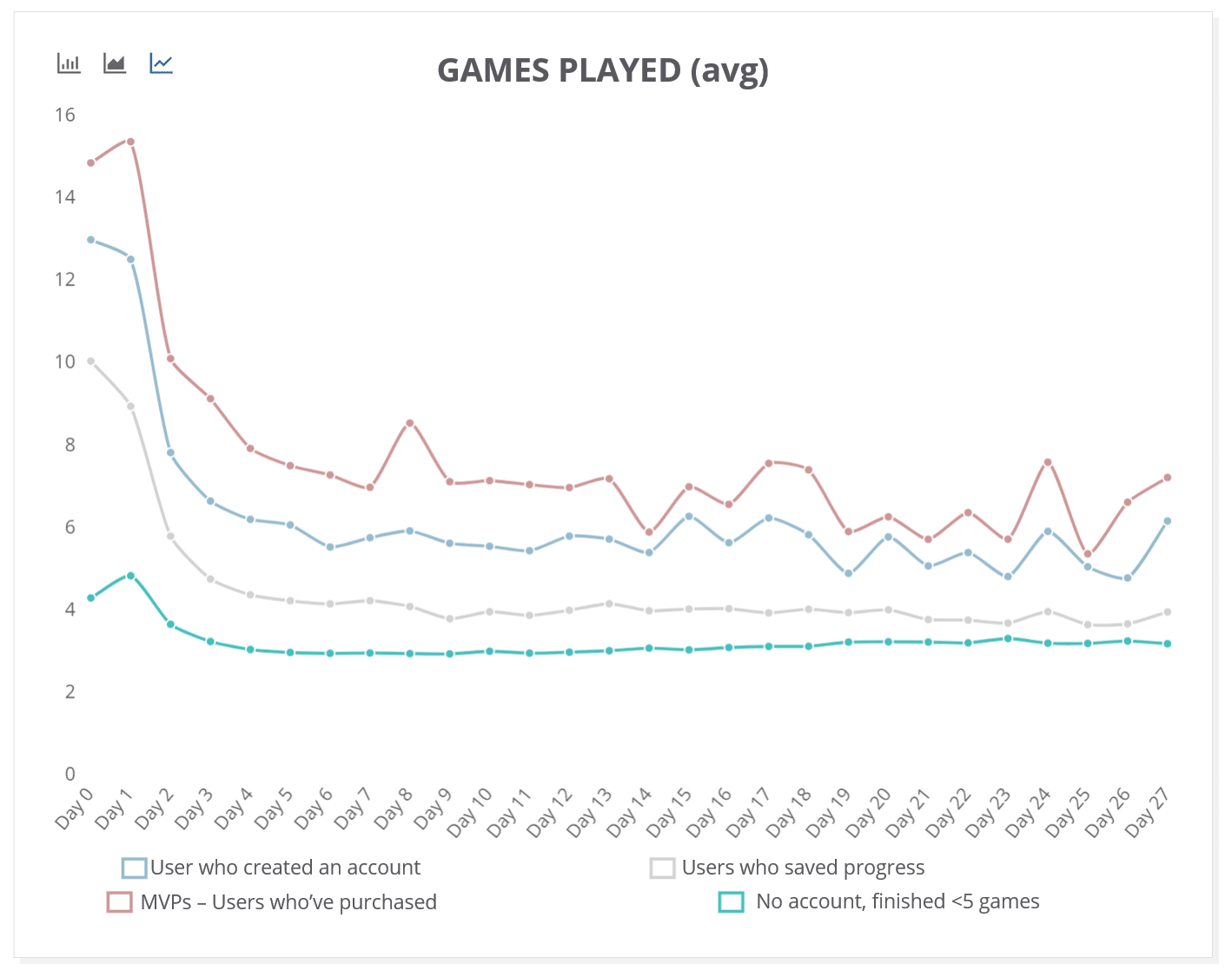The Fundamentals of App Growth

How to grow your app simply: get users. Make app better. Repeat.
Growth is a universal goal for app developers – but how do you get started? Fundamentally app growth falls into one of two categories: getting more users to use an app, and making individual users more valuable while using the app. At first, this may seem a daunting task: this article aims to give app developers some tips from the iterations we’ve seen from our customers.
Work backwards: Start with your MVPs.
Finding the most valuable users of your app may seem at best an ethereal goal, at worst an impossible one. But in broad strokes, this doesn’t have to be difficult at first.
A common discussion we have with app publishers is the desire for “machine learning” or “AI” to help them identify methods for growth. But one of the main problems with applying data science is the proclivity for initial results to be numbingly obvious – and utterly impractical in generating a next step. Anyone that’s experimented with machine learning can commiserate with the following anecdote:
Using Machine Learning: Your first findings
App developer <runs ML library> “find valuable users.”
ML Library: Your MVP users make up 5% of users, they have clicked the “buy” button.
App developer: Ignore result. Find next most valuable group.
ML Library: MVP users have clicked the “add to cart” button.
App developer: *sigh*
The example above isn’t far from the truth, but beginning with an obvious result is still a good place to start. Looking at users across a wide swath can be deceiving in aggregate – so by creating buckets of your most-obviously valuable users can be helpful as a starting point and you won’t need sophisticated methods to do so.
Obvious groups:
Over the years we’ve seen a wide variety of complexity go into the valuation of users – below are some starting points as suggestions on groupings:

Break your users into cohorts
Once you define what makes your “valuable users”, you can aggregate them and proceed to breaking them up into different groups for comparison. Also known as user cohorts.
Defining cohorts is a good way for you to start bifurcating users into differentiated groups. How you break them apart will depend on your goals: we find cohorts generated are most often aligned to the team or person’s ability to control change.

Product makes the app better. So they create cohorts based on user activity.
Generally we find product owners are driving forward KPIs, retention or LTVs of uses within their apps. They are interested in understanding user behaviors and influencing changes to drive users toward a specific goal. Therefore when choosing cohorts, they tend toward looking at user actions or activity in the app:
- Do the number of games completed change the value of a user?
- Does watching a tutorial increase the retention of a user?
- Does getting a “match” on a dating app help keep the user coming back?

Marketing & Growth gets more users into the app. They create cohorts based on acquisition source:
Growth teams that are focused on user acquisition are usually less interested in the app-at-large and are instead more focused on the value of users entering the app. Therefore they will focus on cohorts from the channel or source of the acquisition. This can be as general as the high-level acquisition source (running TikTok ads) all the way down to the most granular bit of data possible (User saw banner 143, served through MoPub, on app Temple Run, installed 7/30/2021).
Granularity comes allows you to measure every dimension but comes at the cost of complexity. Generally apps start general and start to get more sophisticated as their numbers (and budgets) increase.
See also: How do you start buying users for apps?
Measure!
How much does it actually matter between cohorts? It may seem good-enough to make a broad sweeping generalization using averages: however this quickly starts to break down when you don’t have definitive dollar amounts per user.
Some real-world examples of user-cohort measurements we’ve seen:

Ad-tracking opt-ins– Sure it’s important for ad-monetized apps, but how important?
Onboarding tutorials – will likely help keep users more engaged but how much does it actually help user-retention?
Day-1 engagement — Does the amount of games a users completed on day 1 matter for their long-term value?
Determine the user-path for your cohorts
So you’ve uncovered a valuable cohort. Now what? Figure out the behavior – or user-path—that these users take get to this cohort. Specifically what sets them apart from the average user. This is usually done by measuring these cohorts against the average and measuring their interaction with the app against the average.
Above is a cohort report which puts each group of users — defined by their actions, value or other characteristics — on the same user-path, from their install day (day 0) and maps their interaction with the app (average games played per user).
Here we display the daily interaction of games played (on an average per user) among 4 different cohorts. The MVP users (in red) play 2 more games on day 1, a likely behavioral goal would be can the app developer push account-creators (blue) into 2 more games?
Now what? Iterate, measure. Repeat.
This might be the most straight-forward portion of this article but the one that will be ongoing: once you have important user actions that define, influence or lead to valuable users, you can start to make changes that encourage positive behavior and discourage negative behavior:

Product
By measuring the user-path, you can start to experiment with pushing forward valuable behavior. A great example is Random Logic Games – to boost retention and user-value they started experimenting with puzzle logic:
“It turns out there was a very specific formula of a few small easy games interspaced by larger, more complex puzzles that were clear winners. I wouldn’t have guessed this on gut alone but this formula clearly outperformed the baseline by almost 10% — and for our users a 10% difference in LTV can make a significant difference in the profitability of a user.” Alex, Random Logic Games

Marketing & Growth
Understanding the user-path can give marketing teams early insights to the eventual value of a user, this will be used to quickly adjust a campaigns CPI/CAC goals, increasing when a group of users show promise, decreasing – or ceasing—sources that show poor results.
Random Logic Games can be used as an example here as well as they have a daily output of pLTVs by campaign & app to monitor and adjust bids
Interested in talking through your use-case?
We speak to a wide variety of app developers and publishers who are all experimenting and iterating to grow their apps. Are you looking for tips and tricks you can apply to your app? We’d love to hear about them and share our findings.
Interested in better measurement of your user behavior? Our data platform will consolidate your existing data sources and help you get actionable data to help your growth goals. Sign-up for a trial to see if AdLibertas can help your app.
